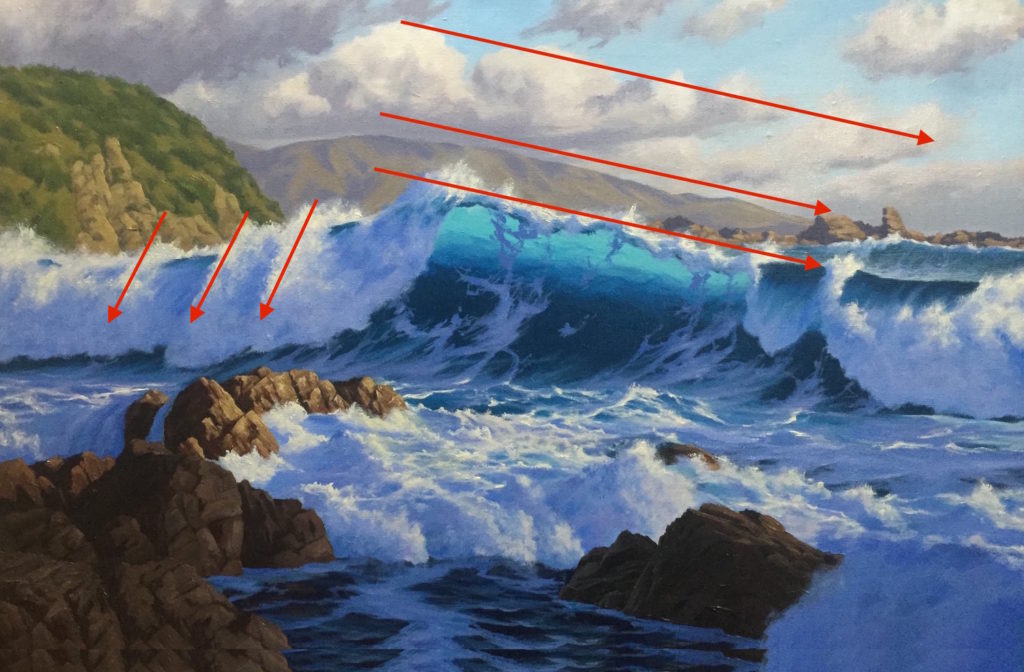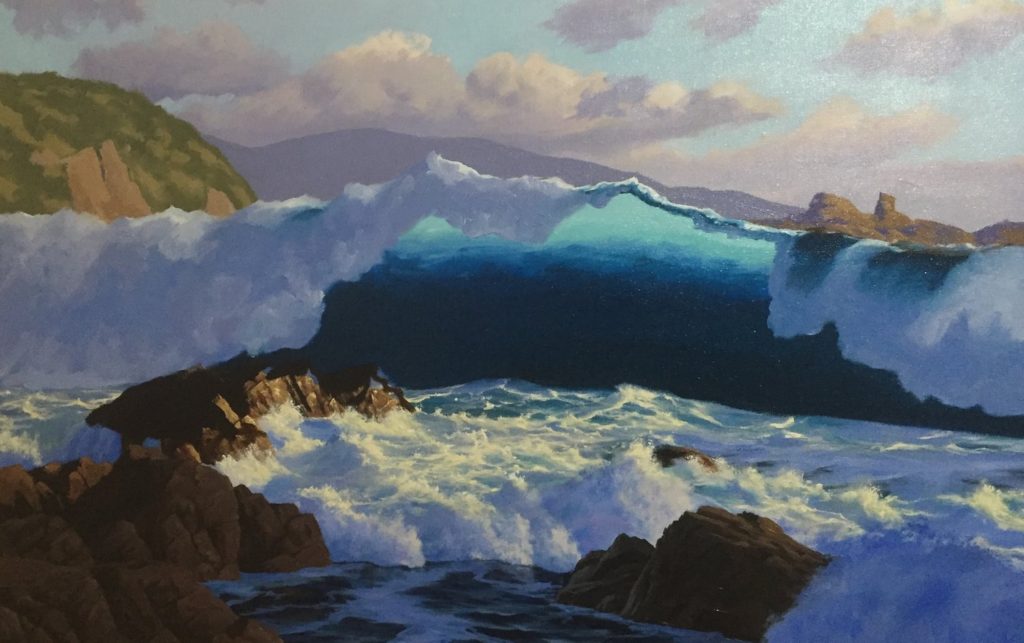Have you ever gotten deep into a painting only to look at it and think ‘oh crap, it’s not working’!!! Don’t worry, this has happened to me many many times! Even with the hours you spent planning your painting and all the sketches you did prior to starting it, sometimes when it comes to actually painting the art work you imagined, it just doesn’t work! But do not despair because you can salvage a painting that is not working!
One of the subjects I love to paint is the coastline around Wellington New Zealand, with beautiful cliffs, vegetation, rocks and wild surf I wanted to create an epic seascape painting that really focused on a breaking wave.
I’ve got some incredible photo reference of the coast of Wellington and I felt particularly drawn to this scene, I loved the evening light on the headland around Houghton Bay and Pencarrow Head in the distance. I also liked the light on the white water and the lip of the breaking wave.
I liked many elements in the above image and I decided I wanted to create a seascape that focused on a big crashing wave but incorporate some rocks, the headland and the distant Pencarrow Head.
After compiling several sketches and a small colour study, I felt happy with starting a 24” x 30” canvas painting. So far as I was blocking in the painting I was happy with it progress. I really wanted to emphasise the translucency of the breaking wave.
I had gotten quite far into the painting and it was becoming increasingly obvious to me that the painting wasn’t working the way I had hoped. There were several things that were annoying me. The first was the fact the wave almost looked too perfect, the archetypical breaking wave, which made it look boring, unnatural and formulaic…and then there were some other more serious problems…
When I looked at the painting I suddenly noticed some serious aberrations in the form of repeating vectors. The lip of my breaking wave was exactly parallel to the shape of the distant headland and to make matters worse the shape of the clouds were also following the same vector.
As I sat back and looked at my painting further I notice more distractions within the composition. The white water on the left in the breaking wave had repeating shapes within it too! How could this have happened? I had been so engrossed in the painting process that I didn’t notice these major aberrations in my painting. It was very disheartening at the time and I decided to take a break from the painting.
Sometimes just stepping back from a painting for a week or so is the best thing to do and this is what I did with this one. After a week I came back to it and asked myself ‘what’s working about the painting’? …well, I still liked the general subject of painting, the dramatic breaking wave and I was happy with the colours and tonality of the painting.
Then I asked myself ‘what’s not working about the painting’? The aberrations in the form of repeating vectors was the main distraction in the composition and the formulaic breaking wave was a major problem. I also felt the horizon line was a little low. One of the main no no’s of seascape painting is having your horizon line right in the centre of the painting and I felt this painting in its current form was entering centre line territory!
Finally I asked myself ‘what could I do to change the painting’? I thought about this and came up with some ideas, I could change the shape of the wave, make the horizon and distant landforms higher and break up and change the shape of the clouds. With this in mind I went back to my sketch book, redesigned the composition then I was ready to get back into my painting.
Using a round bristle brush I marked on the surface of the painting where I was to make the changes that were required.
The beauty of oil paints is that if you make a mistake it’s very easy to paint over it. With this in mind I changed the shape of the wave adding more of a lip and reducing the area of translucency. I repainted the whitewater to eliminate the aberrations that were present before.
As I continued to make the changes to this painting I realised it still wasn’t looking the way I wanted it to and if I was honest with myself it was because I was trying to cut corners after the initial replanning of the painting.
I got lazy and thought I could get away with not increasing the height of the headland in the mid-ground on the left. As a result the landforms in the background were largely obscured by the wave. I felt a little sheepish and I thought for a second that well maybe its good enough to leave it as it is especially as I had spent so much time on it!
In the end, I had to be honest with myself, I still wasn’t happy with this painting and I knew I could do better, close enough ain’t good enough for me! I realised that I had to ignore the fact that I had already spent so long on it and that I need to just sit down, take my time and make the rest of the changes and improvements that it needed…I’d got this far so I had to see it through. Back to the easel!!!!
This time, I boldly made the marks where Round 3 of this painting was to go! I needed to refine the shape of the wave and raise the height of the headlands and cliffs. Also the rocks in the foreground on the left and the clouds were not my best effort so they needed to be changed too.
After taking the time to make the changes I needed and finish the painting I was happy with the end result and I felt I communicated on canvas the vision of the epic breaking wave scene I had in my head. So what did I learn from this? The main thing is if your painting is not working, it’s never too late to change it. If you get stuck with your painting, sit back and ask yourself these questions:
What is working about the painting?
What is not working about the painting?
What can I do to change it?
If needs be take a break from the painting, meditate on it as very often if your mind is still, ideas from the universe will pop into your head, don’t ignore them, write them down and then come back to your painting.
Perhaps you’ve got a painting that you haven’t completed because you got so far into it and you felt it wasn’t working…well maybe it’s time to get it back up on your easel and ask yourself these questions, after all you felt drawn to the subject enough that you wanted to create the art work you had imagined in your head. There was a reason you got out your paints and went for it!
I firmly believe you can salvage paintings that aren’t working by asking these questions, biting the bullet and making the necessary changes. I have found personally that I have learned some of my best lessons in my painting journey from the mistakes I made and I have often found its where I have made my biggest steps forward!
Finally, if you feel your painting is not working, it can be helpful to get a friend, maybe a studio pal who will give you an honest opinion on your art work. Don’t be discouraged if they tell it like it is, whilst it can be uncomfortable you will learn more by taking it on board and making the changes to you need to improve your painting. This will also improve your skills as an artist.
PAINTING LEGEND REVIEW
Seeing that in this blog post I have used one of my seascapes as an example I thought I would draw your attention to one of my favorite seascape artists, Frederick Judd Waugh.
Frederick Judd Waugh was an American painter born in 1861 and died in 1940. He was a predominantly marine artist who painted many energetic and epic seascapes that focused on the movement of breaking waves and their relationship with other elements such as rocks.
For me, I love the atmospheric depth Waugh has achieved with his use of organic natural colour and the tonality of his paintings. The strong emphasis on the breaking waves really draws the viewer into the paintings giving a sense of atmosphere that make you feel like you are really there.
When getting my inspiration for seascape paintings Frederick Judd Waugh is one of my go to painting legends I refer to for ideas.
If you have enjoyed this blog post and want to learn more about my paintings then sign up to my mailing list and be entered in the monthly draw to win a free print
About The Artist
 My name is Samuel Earp, a traditional realism artist who loves to paint landscapes in oils, especially scenes of New Zealand, Australia and Guernsey among others. I was born on the island of Guernsey in 1979 but grew up in the South West of England where I did a lot of drawing and painting from an early age, I always loved landscape art even as a child. I moved to the beautiful country of New Zealand in 2009 and have been there ever since.
My name is Samuel Earp, a traditional realism artist who loves to paint landscapes in oils, especially scenes of New Zealand, Australia and Guernsey among others. I was born on the island of Guernsey in 1979 but grew up in the South West of England where I did a lot of drawing and painting from an early age, I always loved landscape art even as a child. I moved to the beautiful country of New Zealand in 2009 and have been there ever since.
I have a passion for painting landscapes, especially water and the sea, which I enjoy painting most of all. I also love to paint outdoors on location (en plein air).
‘I love recreating the colours, light and atmosphere of nature on canvas. Painting gives me an enormous sense of well-being and connectedness’.
I especially love the dramatic landscapes and beautiful colours that are so unique to the New Zealand wilderness and I channel this into my mountain paintings.
If you have any questions regarding my art works or you would like help with your own painting please feel free to contact me.










Hi Sam, I love your work and realy enjoy watching your tutorials. If I send a photo of one of my tries, could you please comment? I am sure u cant answer all your emails, so I would understand if you cant. Thanks again for all your help.
Denise
South Africa